Google Business Profile
Google Business Profile, also called Google Maps, Google Local, the 3-Pack, etc., has become a crucial centerpiece for lead generation for a local business. With the gradual loss of interest in LSAs and Google Ads, along with mobile searches and social validation, has kept on pushing the usage of Google Business Profile consistently over the years. It is not uncommon for survey after survey to come up with GBP accounting for a minimum of 40% of the click throughs for short-tailed searches (with organic results pushing the other 25% or so). For our own clients, the numbers are unparalleled.
In a recent study of our own clients over the past year, between 60-70% of their organic first-time calls came from Google Business Profile. This number is unprecedented—all of this from a free Google product? It sounds too good to be true, but before anyone can say “because it is”, let’s go through all of the scenarios that could attribute to these numbers being inflated, via the questions I have received from team members and clients rightfully attempting to poke holes in these unbelievable results.
First of all, how can you even tell the calls/leads are coming from Google Business Profile?
We’ll start with the easiest and then work our way down. There are two options that we currently have: CallRail, which is our trusted call (and form) tracking platform that has proven to be spot on with tracking all lead sources, including organic. The second is Google Business Profile itself. There is a dashboard that Google provides.
Here are examples of what both look like:
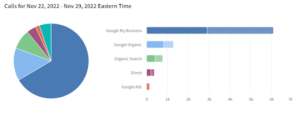
When this is broken down, it will be replete with granular information such as time, duration of call, caller ID, and phone number. There are also filters in which you can designate what requisites would make the call “qualified”.
Google Business Profile provides data, albeit not as well organized or pretty. But in some ways, it is even more insightful than what CallRail and other tracking may offer. More on that in the next questions.
How do you know if the calls are coming from people that already know the firm name?
This is definitely a compelling question. If someone is online and knows the firm name already, are a significant amount of calls coming through the Google Business Profile and then being attributed as a qualified lead? The short answer is yes, there are definitely people that will come in that way and GBP will get the credit for it. The long answer is having the data to find out what percentage.
As you can see in the last image of the Excel screenshot, that data can be provided directly from Google. Under the headings of “Direct Searches” and “Discovery Searches”, Google defines these as being your branded vs. non-branded, respectively. Direct Searches will be counted when the search term used was the firm name or something very similar to the firm name (or an attorney). Non-branded would have been a search for a lawyer/attorney without using a firm name. For this particular client, you could say as many as 40% of the GBP searches they received were branded searches, which is quite high. After going through dozens of clients over a longer period of time (about a year), this number is closer to 20%.
That means that when our clients are receiving 60-70% of their leads from their GBPs, we can expect the number to be closer to 48%-56%, which is still outstanding.
If you look on Google Search Console for how impressions/clicks come in through the homepage of your website, you’ll generally see that the homepage of your website will get much more of its traffic from first-time visitors from branded vs. non-branded.
If the results for your clients are so heavy on Google Business Profile, does that just mean your organic SEO isn’t working as well since it’s all relative?
This may be the case for some campaigns that are just getting their start, and the client has their GBP get traction before their long-term SEO and Content Marketing strategy. Organic results have a journey when it comes to rankings—getting from page 5 to 3 to 2 to 1, from the first page 8th position to the 5th to the 3rd, 2nd, 1st. You get the point.
When it comes to GBP, proper optimization can fast-track you to the 3-pack. This would create the impression of GBP being by far the leader in the lead generation. We’ve seen this for clients when they have 85% of their leads coming from GBP. We’ve seen from others that when their blogging and organic is doing very well, GBP is closer to 35%. But at 35%, it is still a respectable source of leads for this particular campaign.
We can’t assume every person has a preference for GBP searches. On average for a short-tail search, 20-25% of people will pass Local Service Ads, Google Ads, and Google Business Profile for organic. And for long-tail searches, Google Organic is often the only available SERP type.
Is there an “SEO” or “Optimization” process that goes into this to make the profile show up?
There certainly is, which can include but isn’t limited to:
- Citations
- Data Aggregation
- Local/Geo-Optimized Content on Your Website
- Localized Link Building
- A Review Generation Plan in Place
There are ways that your current SEO on your website and the optimization efforts for GBP overlap, but you’ll want a plan specifically on the local side.
What if I have trouble getting reviews? Will this affect the campaign?
It almost certainly will. While it seems that the correlation between quantity/quality of reviews is a bit lower than it was, say, 5 years ago, your placement is only going to look as good as the reviews that are relative to yours. For example, even if you rank number one on Google Business Profile for all of your keywords, if your review quantity and quality is significantly worse than number 2 and 3, then the chance of the average consumer contacting you will drop off significantly.
It is important to have a plan in place for positive lead generation, Google rankings or not, consumers will be looking at your reviews whether it’s because of an organic search or a word-of-mouth referral.
I already show up at the top when you do the searches, what else is there to do?
If you’re already positioned well for your local keywords, the next step is looking at how far those rankings reach. Let’s refer back to the image at the beginning of the post for this one:
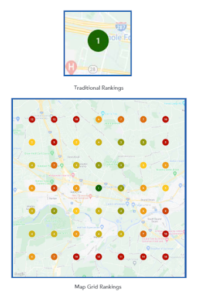 Many local rankings only consider a ZIP code or an arbitrary point in a city. It is also important to use tools like LocalFalcon and LocalViking to have a grid ranking system to see at what point your placement drops off, because it will. Google doesn’t deliver a good experience showing a local business 12+ miles away from where the search is conducted. But maybe you can stretch your reach another 1-2 miles in every direction, which would be exponential coverage. Many local rankings only consider a ZIP code or an arbitrary point in a city. It is also important to use tools like LocalFalcon and LocalViking to have a grid ranking system to see at what point your placement drops off, because it will. Google doesn’t deliver a good experience showing a local business 12+ miles away from where the search is conducted. But maybe you can stretch your reach another 1-2 miles in every direction, which would be exponential coverage.
Can I pay for placement on these listings?
Occasionally you’ll see an “Ad” in the 3-pack, effectively pushing out to being a 4-pack. This is typically a local extension that is done with Google Ads. Though this technically means “Yes, you can pay for placement on these listings”, the Ad association is exactly what the average consumer just passed on the way down from LSA’s and Google Ads, so it stands to reason that the clickthrough for the Ad position on the 3-pack won’t be as useful. Also, if you already have a 3-Pack Position, you won’t be able to have two.
GBP doesn’t show up for every result, does that make it less valuable?
It doesn’t make it less valuable; it just means there’s a limitation to GBP being in front of every potential high-intent search that exists. It is the dominant result for short-tailed search (e.g. (city) (practice area) lawyer/attorney/law firm). It does show that an SEO campaign has to be diverse in creating different types of content such as blogs and articles to be in front of any potential valuable long-tail searches.
If this works so well, why wouldn’t I just open a million virtual offices?
If only! Google has made it tremendously more difficult to register virtual offices and get approval in 2022. Many times, you’ll have to verify using a video, signage, all the while speaking with a Google agent to prove its validity. In some cases, with the right team to systematically execute a tried-and-true process, you can make the strategy work while avoiding Regus, Opus, Da Vinci, WeWork, and other common generic VO companies. But it is incremental, and you can expect there to be delays and suspensions. Consider this Google’s modern-day equivalent of cracking down on SEO keyword stuffing and link building farms.
Maximize the Potential of Your Google Business Profile with Market My Market
More people search for businesses online than anywhere else, so it’s crucial that your company ensure your local business listing can be found on Google. At Market My Market, our content marketing and SEO experts will work with you to ensure you’re completely visible online so you can expand your customer base and, in turn, increase revenue. To discover more ways to elevate your marketing strategies, complete our online contact form or call us at (800) 997-7336. |
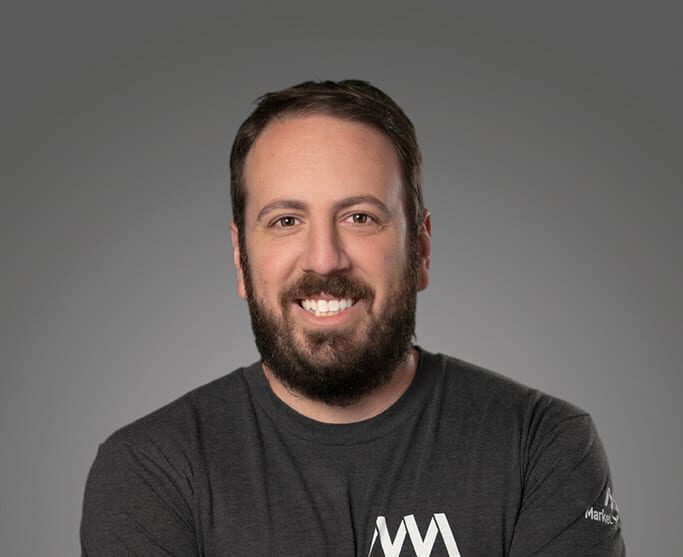

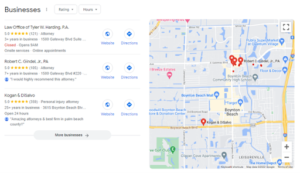
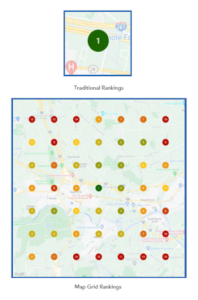 What you are seeing above is what happens to most of us when we search for our business, from our office, or close by. Or we peg our local ranking results to our exact zip or immediate area. We have peace of mind we are at the top, but if you look at the image above called “Map Grid Rankings” (which is pulled from an extended local tracking tool that we use for these campaigns), most of the time our local ranking drops off immediately via an extended radius.
What you are seeing above is what happens to most of us when we search for our business, from our office, or close by. Or we peg our local ranking results to our exact zip or immediate area. We have peace of mind we are at the top, but if you look at the image above called “Map Grid Rankings” (which is pulled from an extended local tracking tool that we use for these campaigns), most of the time our local ranking drops off immediately via an extended radius.
 Many local rankings only consider a ZIP code or an arbitrary point in a city. It is also important to use tools like LocalFalcon and LocalViking to have a grid ranking system to see at what point your placement drops off, because it will. Google doesn’t deliver a good experience showing a local business 12+ miles away from where the search is conducted. But maybe you can stretch your reach another 1-2 miles in every direction, which would be exponential coverage.
Many local rankings only consider a ZIP code or an arbitrary point in a city. It is also important to use tools like LocalFalcon and LocalViking to have a grid ranking system to see at what point your placement drops off, because it will. Google doesn’t deliver a good experience showing a local business 12+ miles away from where the search is conducted. But maybe you can stretch your reach another 1-2 miles in every direction, which would be exponential coverage.
